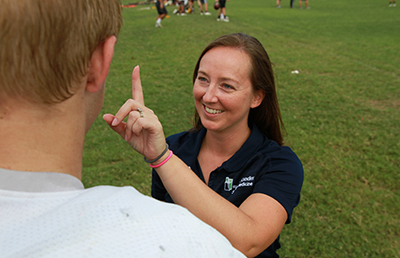Education may be the best tool to protect against concussions
Neurology, Family Health
St. Joseph’s/Candler certified athletic trainer offers tips to reduce the risk of getting a concussion
Accidents happen – on the sports field, on the job, in the car or even at home – that can result in a concussion. However, there are steps you can take to prevent brain injuries whether it’s a young athlete or an elderly parent. It starts with education.
A concussion is a type of traumatic brain injury caused by a bump, blow or jolt to the head or a hit to the body that causes the head and brain to move rapidly back and forth. There’s no bleeding or fracture when a concussion occurs, but the sudden movement that causes the brain to bounce or twist can create chemical changes in the brain and damage brain cells. 
Concussions should be taken seriously and never ignored, says Caroline Brif, lead certified athletic trainer who currently treats patients at St. Joseph’s/Candler Physician Network – Bone, Joint & Muscle Care with Dr. Steven Greer.
“It is a brain injury,” Brif says. “One of the key pillars we talk about is recognizing it, and in sports, removing the athlete from play because the threat of getting hit a second time is when you can have lasting, significant brain damage. So it’s very important to recognize when someone has signs of a concussion.”
And those signs can include:
- Headache
- Confusion
- Lack of coordination
- Memory loss
- Nausea and/or vomiting
- Dizziness
- Ringing in the ears
- Excessive fatigue
Related Article: Having an ImPACT on concussion diagnosis
Preventing concussions
Associations from youth football to high school soccer to professional basketball have made efforts to reduce the risk of concussion. In Georgia, for example, the state high school football association limits the amount of contact minutes held during practice each week. In youth soccer, there’s a maximum amount of practice time for headers per week.

“The rule changes that have been implemented over the last five or 10 years have been successful,” Brif says.
There are other ways to reduce the risk of concussion for anyone including:
- Always wear proper headgear, including helmets for football, lacrosse and baseball players, bike riders and boxers
- Enforce the rules of the sport for fair play, safety and sportsmanship
- Make sure your athletes are comfortable reporting signs of a concussion
- Limit contact during practice
- Teach athletes proper ways to avoid hits to the head and not to target or spear opponents
- Wear a seat belt every time you’re in a motor vehicle
- Reduce the risk of falls by eliminating clutter in your home, removing slippery rugs and installing grab bars in the bathroom, if needed
- Never work on a ladder if you feel dizzy or lightheaded or if you’ve been drinking alcohol or take medications that make you dizzy
- Have your vision checked at least once a year. Poor vision can increase your risk for falls and other types of accidents
St. Joseph’s/Candler’s Sports Medicine program has athletic trainers at five schools in the area, five co-workers in urgent care and Brif at Bone, Joint & Muscle Care. To learn more about our Sports Medicine program, visit our website.
If you are a parent, coach or other that would like to learn more about preventing concussions in children and teens, the Center’s for Disease Control & Prevention’s HEADS UP initiative is a great resource. Visit the website to learn more.